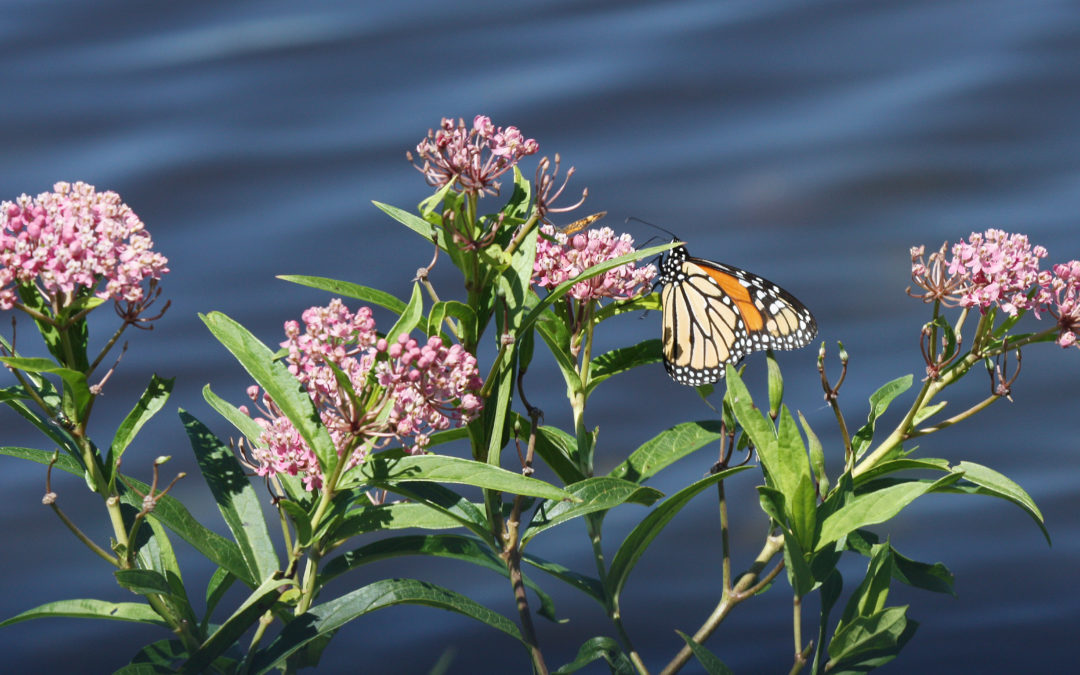
by Janice Gammon | Feb 28, 2020

Monarch on a Swamp Milkweed by Carl Kurtz
There are signs of spring 2020 along the Lincoln Highway! In some places, snow has melted away and some flowers are busting through the soil. That means spring is just around the corner. Home and Garden Shows are being held in many communities across Iowa. Also Camping and Boating shows! These types of events get people excited for warmer weather and for the eventual summer.
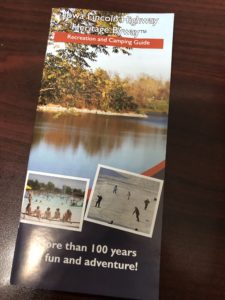
Lincoln Highway Heritage Byway Recreation and Camping Guide
Also check our our Lincoln Highway Heritage Byway Recreation and Camping brochure for ideas of where you can go along our route and enjoy the outdoors.
https://old.prrcd.org/wp-content/uploads/2018/03/10-18.UPD-Camp26RecBrochure.pdf What preparations are you making for spring? Cleaning closets? Raking the yard? Perusing garden catalogs and magazines? Getting your fishing gear ready? We all know that Thursday, March 19th is the first official day of spring, but, as Iowans, we know it can still snow in April and be chilly in May. What can we do in preparation in the meantime for the Lincoln Highway Heritage Byway to get ready for spring? We know the Department of Transportation is tasked with handling the physical road repairs, but what can we do as a group or as an individual for the Byway? On my way to work today, I noticed some trash along the ditches and medians. Does your section of road have groups that participate in Adopt-A-Highway? If not, do you know of a group that could? Now I am not suggesting that you go into the median of a busy highway yourself to pick up trash without proper training or a safety vest, but if you are a landowner perhaps cleaning up your own ditch makes sense. (I know most do already.) If you live in the city, as I do now, ask your city how you can be part of a city-wide cleanup day. Perhaps there is a group that spruces up the entrance to your town to make it more inviting, not only for visitors, but for residents. This makes an impact on all and increases community pride. Some communities do a “swap” where leaders in one community go to another to view the community through “new eyes” as to what works well and what could be improved. Then leaders from that community go to the other and do the same type of review. Sometimes we don’t even notice things in our own back yard as we are accustomed to them. The official Iowa Byways sign for the Lincoln Highway Heritage BywayAre there buildings that could do with a fresh coat of paint? Every year
Paint Iowa Beautiful offers, through a grant application process, a chance to obtain paint through their program. (Sorry the 2020 deadline has passed, but please remember this for next year.)
One of my spring goals is to finish the Lincoln Highway Heritag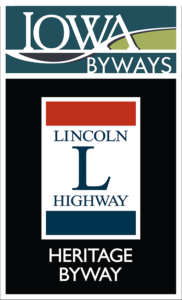 e Byway signage inventory. I know there are signs in 2 counties and 2 communities that I need to address. It’s been an on-going process for several years now. (There are 1200 signs across the state to monitor!)
e Byway signage inventory. I know there are signs in 2 counties and 2 communities that I need to address. It’s been an on-going process for several years now. (There are 1200 signs across the state to monitor!)
Also on my list of to-do’s are to continue supporting attractions that are in need of restoration. Preston’s Station, Quirks’ Cabins, and a gas station in Montour are among the priorities. We are also planning several interpretive installations across the state that will increase education and promotion of the road.
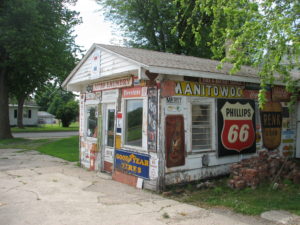
Preston’s Station Historic District in Belle Plaine, Iowa taken by Mike Kelly
Let us know what spring events you have in the works and how we can help you promote them.
by Janice Gammon | Nov 19, 2019
The world of Byways changed on September 22, 2019 when “Reviving America’s Scenic Byways Act of 2019” was signed into law. It passed out of the U.S House of Representatives on a vote of 404-19 earlier this year and then was passed unanimously in the Senate. The President signed it on 9/22/19. The bill directs the U.S. Secretary of Transportation to restart the nomination process for National Scenic Byway status within 90 days of enactment, and to make a round of designations within one year.We are very grateful to Sen. Susan Collins (R-ME) and Sen. Ben Cardin (D-MD) for their leadership on the bill in the Senate and to Rep. David Cicilline (D-RI) and Rep. Garret Graves (R-LA) for their leadership in the House. See what other groups have to say about the passage of this bill and what it means for America at https://www.scenic.org/blog/president-signs-national-scenic-byways-bill-into-law/
We, at the Lincoln Highway Heritage Byway, are patiently waiting to see what the guidelines and nomination requirements are for this re-energized program. Only in Illinois is the Lincoln Highway a National Scenic Byway. The route in the states of Nebraska, Iowa, Indiana, Ohio, and half of Pennsylvania are state byways. The other states (New York, New Jersey, West Virginia, Wyoming, Utah, Nevada, and California) have not designated their portion of the historic route as a byway. One must first be a state byway before becoming a national byway.
In Iowa, we have two National Scenic Byways- the Loess Hills National Scenic Byway and the Great River Road National Scenic Byway. The Loess Hills runs along the western edge of the state and the Great River Road is along the Mississippi River on the eastern edge of Iowa. The Lincoln Highway connects to both of them.
Now keep in mind that no funding was attached to this bill. This is only to take nominations and approve byways for this distinction. That does not mean that funding couldn’t happen in the future, but it was not part of this bill.
A Corridor Management Plan has been a requirement in the past. We completed ours in late 2016 and have been working hard to implement the projects identified in that process. Twenty interpretive panels in 8 communities have been created and we have plans for several more. The rou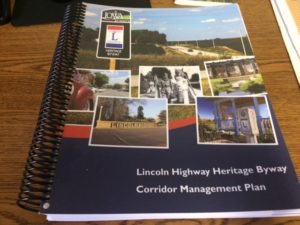 te has also been promoted in brochures, presentations, and at the Iowa State Fair. We have partnered with universities, government entities, other non-profits, and citizens to retain this historic road and its varied resources.
te has also been promoted in brochures, presentations, and at the Iowa State Fair. We have partnered with universities, government entities, other non-profits, and citizens to retain this historic road and its varied resources.
As we keep the momentum going, writing grants and planning projects, we desire to become a National Scenic Byway one day. We see the possibility on the horizon.
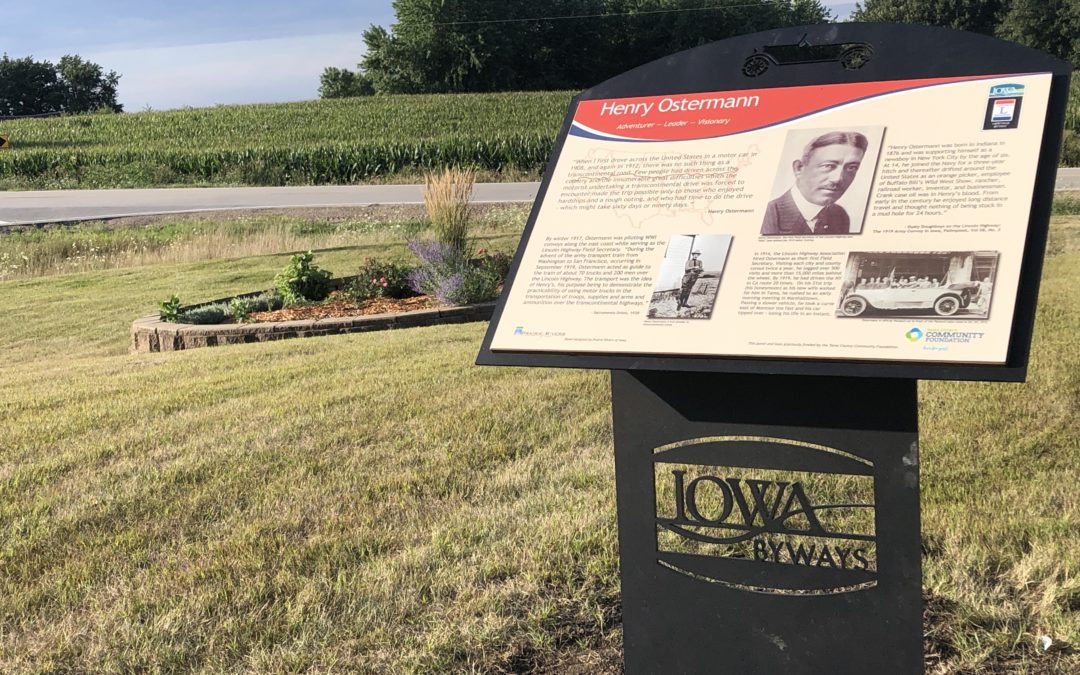
by Janice Gammon | Aug 27, 2019
Can summer really be over? It seems every year it goes faster and faster. We, here at the Byway office, seemed to have packed quite a bit into our last 3 months. Five communities celebrated 150 years this summer- Carroll, Dow City, Grand Junction, Scranton, and Westside. 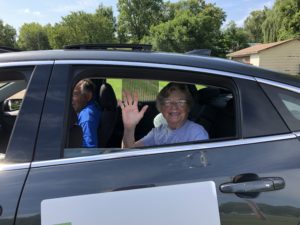 We entered a car into several of the parades and had Bob and Joyce Ausberger, Lincoln Highway Association members, help toss candy out to the crowd in Grand Junction. What a great way to share in the fun!
We entered a car into several of the parades and had Bob and Joyce Ausberger, Lincoln Highway Association members, help toss candy out to the crowd in Grand Junction. What a great way to share in the fun!
The Lincoln Highway Heritage Byway took 4 of the 11 days at the Iowa Byways booth under the grandstand at the Iowa State Fair (Aug 8-18) and talked to fair-goers about the unique Bywa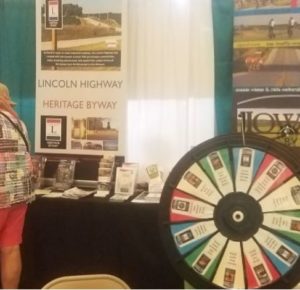 y routes in Iowa. We shared some history in a trivia spinning-wheel game. Everyone, of course, got a prize!
y routes in Iowa. We shared some history in a trivia spinning-wheel game. Everyone, of course, got a prize!
This year our new featured booklet at the fair was about the original 1919 Army Convoy, the Lincoln Highway, Henry Ostermann (the idea man behind the convoy and a man we have written about before), Dwight Eisenhower (who was on the original convoy)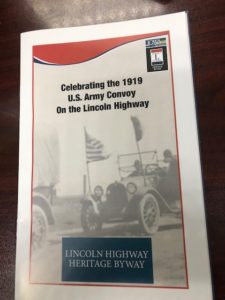 , and Dwight’s wife, Mamie, (who was born in Boone, Iowa). These booklets are available at some state Welcome Centers and select locations along the Byway route. And of course, you can always request copies from our office at jgammon@prrcd.org
, and Dwight’s wife, Mamie, (who was born in Boone, Iowa). These booklets are available at some state Welcome Centers and select locations along the Byway route. And of course, you can always request copies from our office at jgammon@prrcd.org
On August 15th, we unveiled an interpretive panel in the City of Montour’s Maple Hill Cemetery. This panel serves as a long overdue memorial to Henry Ostermann, who served the Lincoln Highway Association as their first Field Secretary and knew the road and the route better than anyone. He had been piloting convoys up and down the east coast in 1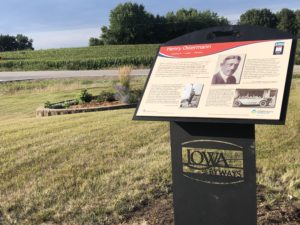 917 and came up with the idea to test men, equipment, and roads by taking a convoy across the nation- on the Lincoln Highway. His idea was a reality in 1919. In 1920, on his 21st trip across the nation (and his honeymoon), he lost his life in an accident east of Montour, near the cemetery. In the August-September 1920 Iowa Highway Commission Service Bulletin, the IHC called for a memorial to be placed near the accident site.
917 and came up with the idea to test men, equipment, and roads by taking a convoy across the nation- on the Lincoln Highway. His idea was a reality in 1919. In 1920, on his 21st trip across the nation (and his honeymoon), he lost his life in an accident east of Montour, near the cemetery. In the August-September 1920 Iowa Highway Commission Service Bulletin, the IHC called for a memorial to be placed near the accident site.
In 2019, it became a reality (99 years later). About 25 people gathered to witness this installation. A small program consisted of several speakers: Reed Riskedahl (Prairie Rivers of Iowa Board); Mary Preston (Iowa Lincoln Highway Association President); Dotti Thompson (Community Foundation of Northeast Iowa/Tama County Community Foundation); Rev. John Christianson (Living Faith Methodist Church of Montour), Sue Eberhart (Montour City Council); and Jan Gammon (Lincoln Highway Heritage Byway Coordinator). Gammon also reads words from Rep. Dean Fisher of Montour. Sue Eberhart and Vicky Garske, Montour City Council members, unveiled the panel for all to see. During the program, a few sprinkles fell from the sky. In retrospect, maybe it was Mr. Ostermann verifying his overdue acknowledgement.
A few days later, we celebrated Mr. Ostermann once again as the Military Vehicle Preservation Association (MVPA) retraced the route of the original 1919 Convoy. The original convoy traveled about 6 mph and this modern day group, with vintage vehicles, averaged 35 mph. There was a link to live tracking, so a person could fo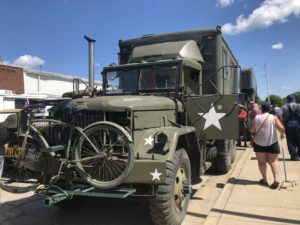 llow the convoy as it made its way across America. Our Byway staff caught up with the convoy in Belle Plaine, Iowa and then saw them again in Tama, Marshalltown, and Nevada. The convoy was impressed by the amount of people who came out to see them- whether on a city street or at the end of their rural lane. Byway staff had helped promote this event in Iowa- sending out press releases, sharing our booklet, and doing interviews with KROS Radio in Clinton and also with RadioIowa. We are most appreciative to the public for their response.
llow the convoy as it made its way across America. Our Byway staff caught up with the convoy in Belle Plaine, Iowa and then saw them again in Tama, Marshalltown, and Nevada. The convoy was impressed by the amount of people who came out to see them- whether on a city street or at the end of their rural lane. Byway staff had helped promote this event in Iowa- sending out press releases, sharing our booklet, and doing interviews with KROS Radio in Clinton and also with RadioIowa. We are most appreciative to the public for their response.
The Lincoln Highway Association will also bring a convoy of classic and contemporary cars, retracing the same route. They will be in Iowa September 6th and 7th, overnighting in Marshalltown and Council Bluffs. They will go a little faster!
Now with fall approaching, its time to regroup and look for funding for future projects. We have some already being planned, so stay tuned!
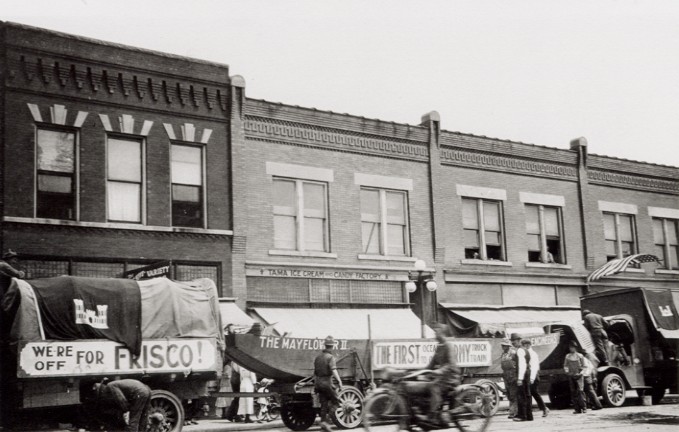
by Janice Gammon | May 23, 2019
One hundred years ago, in what began as the idea of one man, America was shown how motor trucks could transport troops, supplies, arms, and ammunition across the nation. This was known in 1919 as the First Trans-Continental Motor Transport Convoy.
The Idea and Development
Henry Ostermann, who we talked about in a previous writing, had been piloting convoys for the Army up and down the east coast in the winter of 1917, during World War I. He was also serving as Field Secretary for the Lincoln Highway Association and merged his two occupations into one idea for the convoy.
In “A Picture of Progress on the Lincoln Way”, published by The Lincoln Highway Association (LHA) in 1920, the LHA officers and the General Staff in Washington held a conference in June 1919 to discuss convoy details. The success of the run was due to the LHA supplying accurate data to the Army as a “result of its years of study of trans-continental highway conditions, and of the co-operation given to the Motor Transport Corps, not only by the Headquarters of the Lincoln Highway Association, but by the consular representatives all along the line between the two coasts. The spirit with which the undertaking was met by the general public and the highway officials at every point along the route, was also invaluable to the project.”

The 1919 Army Convoy taking a break in Tama, Iowa. LHA Archive, Transportation History Collection, Special Collections, University of Michigan
The Route and Key Personnel
On July 7, 1919, send-off ceremonies were attended by high ranking United States officials, including Secretary of War Baker; General Marsh, Chief of Staff; and many leading U.S. Senators and Representative. At the conclusion of the celebration, the convoy left from “Zero Milestone” near the south lawn of the White House in Washington, D.C.. A marker stands there yet today to commemorate this historic adventure undertaken by the Army. The convoy left from Washington and caught the Lincoln Highway at Gettysburg, Pennsylvania. (The Lincoln Highway actually begins in Times Square in New York.)
From the LHA, “The convoy, consisting of 72 vehicles, 65 of which were motor trucks of all types used by the Government during the war, with a personnel of 260 men and 35 officers as statisticians and observers for the various branches of service, under the command of Lt. Col. Charles B. McClure and Capt. Bernard McMahan, and led by Field Secretary and Vice-President H.C. Ostermann of the LHA, in the Association’s Packard, traversed the continent, covering a distance of 3310 miles from Washington to San Francisco, in sixty-two days, arriving only four days behind the schedule laid out in Washington before the start.”
A young Lt.Col. Dwight Eisenhower was one of the men on this trip. He caught up with the convoy at the first overnight location in Frederick. Maryland. He wrote about his experience and his report is on file at his Presidential Library and Museum in Abilene, Kansas. https://www.eisenhower.archives.gov.

Washing dust from a 1919 Army Convoy vehicle in Cedar Rapids. LHA Archives, Transportation History Collection, Special Collections Library, University of Michigan
What the Convoy Taught Us
Eisenhower found most of the drivers in need of additional training and, as with the rest of the convoy leaders, felt the nation’s roads to be lacking. In the Eastern United States, they were often paved but sometimes too narrow for the large equipment. West of Chicago, roads became graveled. Iowa was lucky because it had not rained which would have turned the unpaved road to “gumbo.” The “Seedling Mile,” a one mile of paved road in Linn County near Cedar Rapids, Marion, and Mount Vernon, was completed just prior to the Convoy. The group did not write about it much. As it was, the ground in Iowa was very dry and the convoy, according to the State Center Enterprise, stretched out for as much as 10 miles. Vehicles were kicking up quite a bit of dust and hindering the men and trucks following them. Nearly one hundred bridges were broken and repaired across the nation, though we have no record of any in Iowa. (Iowa was a leader in bridge building.)
This experience showed that America needed to improve roads and the federal government needed to step in with funding instead of leaving it to the locals and counties to build their own roads. How county secondary road departments, county engineers, Federal Highway Commission, and the Department of Transportation developed is a story all its own- which we will address in a later writing.

1919 Motor Convoy crossing the Lincoln Highway Bridge in Tama, Iowa. LHA Archives, Transportation History Collection, Special Collections Library, University of Michigan

What could have happened in Iowa if it had rained! LHA Archives, Transportation History Collection, Special Collections Library, University of Michigan
Celebrating the Convoy 100 Years Later
This one idea from one man helped change the course of transportation. This year, in 2019, we will celebrate the convoy as the Military Vehicle Preservation Association (MVPA) travels the same route, from Washington, D.C. to San Francisco, and will overnight in Iowa- DeWitt (Aug 22), Marshalltown (Aug 23), and Denison (Aug 24). The MVPA call their convoy the “longest Veteran’s parade in the nation.”
The Lincoln Highway Association will also celebrate with their own D.C.-to-San Francisco convoy and overnight in Marshalltown (Sept 6) and Council Bluffs (Sept 7). Be sure to line the route and wave either flags or hands (or both) to the convoys as they come through your neck of the woods.
by Janice Gammon | Nov 19, 2015
In my first year as the coordinator, I have enjoyed traveling on the Lincoln Highway Heritage Byway and seeing the seasons change. I remember how wonderful it was to see the green grass emerge and the trees starting to bud. Then later in summer, due to timely rains, the grass remained green and the crops were maturing. This fall, everything seemed to be a golden color as crops were harvested and tree leaves began change color and drop.
Today the sun is out, but the wind is howling and tomorrow’s forecast is for SNOW! We all knew it would happen sometime and I guess we should be happy we have avoided it so far. I know as an Iowan, snow is inevitable. This forecast has me thinking.

© Carl Kurtz
Yesterday, I was asked to submit winter photos along the Byway for a marketing program. As I looked at the photos we have on file, I began to make peace with the approaching season. Winter can be truly beautiful. There was the photo of a cottonwood stand against a winter blue sky and the crisp new white snow. Reminded me of my childhood home and the cottonwoods in our yard and along the creek.

© Mike Whye
In another picture, an older barn and the newly fallen snow looked so quiet and peaceful. I could almost hear the crunch of the snow under my feet, if I were to walk towards the barn. Compare that to the photo of people skiing at Seven Oaks near Boone. There were people in the ski lifts and parents, children, and teenagers enjoying the day. Lots of voices, laughing, and shouts to each other would fill the air. I can imagine they will be sad when that season ends and the snow melts away.
Even the photo of a random snowbank makes you stop and think how does Mother Nature make such interesting sculptures with just moisture, cold, and wind? Compare that to the photo of the snowplow blowing through large drifts on the roadway. We rely on these public servants to keep us safe while we travel whether for business or pleasure.
And the photo of the Reed-Niland Corner, still open for business. Carrying on. Won’t let a little snow stop them from serving great food and sharing the story of the Lincoln Highway with visitors.

© City of Colo
Snow is coming. It will happen. How will I enjoy it? You know, years ago I tried cross-country skiing in Canada. I really enjoyed it. I always thought I’ d like to try it here in Iowa. Hmm. This might be the year. I know of many county and city parks around me where skiing might be possible. I just might head to the outdoor store and get setup to do that!
Let me know how you are going to enjoy this season along the Lincoln Highway Heritage Byway. Whether it might be ice fishing, snowmobiling, snowshoeing, or even joining me in some cross country skiing, share your experiences on our Facebook page. This Byway can be enjoyed anytime of year! It has so much to offer.

 e Byway signage inventory. I know there are signs in 2 counties and 2 communities that I need to address. It’s been an on-going process for several years now. (There are 1200 signs across the state to monitor!)
e Byway signage inventory. I know there are signs in 2 counties and 2 communities that I need to address. It’s been an on-going process for several years now. (There are 1200 signs across the state to monitor!)


















